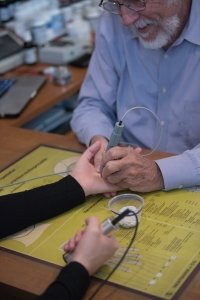By Cristina McMullen, Bio-Energetic Practitioner, Certified Wellness Coach
 The last couple of years have been a doozie! The novel Coronavirus, SARS-CoV-2, disrupted life as we knew it. So much happened around us that was out of our control, resulting in so much fear and anxiety in us and the people we love. Not to mention all of the uncertainty about the future, as it doesn’t seem like things will go back to “normal” anytime soon.
The last couple of years have been a doozie! The novel Coronavirus, SARS-CoV-2, disrupted life as we knew it. So much happened around us that was out of our control, resulting in so much fear and anxiety in us and the people we love. Not to mention all of the uncertainty about the future, as it doesn’t seem like things will go back to “normal” anytime soon.
All of the stress weighing heavily on us during this season has a negative impact on our immune systems, right when we need them to be at their strongest! But there are some simple steps we can take today to help strengthen our mental, emotional, and physical health, protecting our mind, body, spirit, and immune systems in the wake of this pandemic.
Breathe, Meditate, and PRAY
We’re all guilty of focusing on the negative things in life at times. This gets compounded when all we hear and see everywhere is negative, and often conflicting information. This is where we need to STOP listening to the news, STOP scrolling social media, and retreat to a quiet space. Empty your thoughts and just try to relax. Take some deep belly breaths while thinking about all of the good things that you have going for you. What are all of the things you are grateful for? The deep breathing will send messages to your brain to calm down and relax, and counting your blessings will help you focus on all the positive things around you.
We must also not forget the power of prayer. The Bible says “Do not be anxious about anything, but in every situation, by prayer and petition, with thanksgiving, present your requests to God. And the peace of God, which transcends all understanding, will guard your hearts and your mind in Jesus Christ.” (Philippians 4:6-7).
The more we turn our eyes to our Heavenly Father, the more at peace we will become with the chaos around us. He has the power to ease our fears. This is because, through Him, we do not have a spirit of fear, but one of power, of love, and of a sound mind. When we find rest in Him, He provides us everything we need to live a more peaceful, healthier life.
Eat a Nutrient-Dense, Virus-Fighting Diet
 Every time you take a bite of something, you are either promoting disease or fighting it. Now is a time that we really need to be focusing on the foods that help to fight disease and avoiding those that promote it.
Every time you take a bite of something, you are either promoting disease or fighting it. Now is a time that we really need to be focusing on the foods that help to fight disease and avoiding those that promote it.
Things that we should be avoiding right now include packaged, highly processed, and sugar laden foods. These foods not only lack the nutritional value that we are supposed to be getting from the food we eat, but they contain a lot of fake, chemical ingredients that are foreign to our bodies. And when our immune systems see something foreign they trigger an inflammatory response. Things high in sugar also directly impact our immune systems. Did you know that within 30 minutes of eating simple sugars, the ability of some of our white blood cells, called macrophages, to “eat up” bacteria and viruses decreases by 50%? And that lasts for at least 5 hours!
As we cut out sugars, we need to focus on eating more nutrient-dense foods. These include an array of colorful fruits and vegetables, lean meats (especially those high in omega 3 fatty acids), and a plethora of fresh herbs. By eating the colors of the rainbow, you are sure to get a wide variety of phytonutrients and antioxidants as well as vitamins and minerals like A, C, D, Zinc, Quercetin, and Sulfur for proper immune function and antiviral support. Herbs like Rosemary, Thyme, Sage, and Oregano all have antiviral properties to them as well and have actually be shown to kill other forms of coronaviruses.
Remember to relax and actually enjoy your meals. We have become a society that is so busy with life that we no longer sit down to enjoy the food we are eating or the company we are eating with. This “eating on the go” makes it super hard for our bodies to actually digest what we are eating, and thus prevents us from absorbing the nutrients we should be getting from our food.
Hydrate
Not only is water good for our overall physical health, but it is actually good for our emotional well-being as well. In Traditional Chinese Medicine, each organ is associated with a given emotion. It is believed that, if an organ is under stress or isn’t functioning optimally, then that person would be more likely to experience the emotion associated with that organ. The kidneys are the organ that benefit the most from proper hydration. And can you guess what emotion is associated with kidney health? FEAR. So make sure you are getting at least half of your body weight in ounces of water daily.
Exercise
Exercise and all forms of physical activity increases our overall health and sense of well-being. Ever heard of someone say they needed to go for a run in order to blow off some steam? Well, this is because, while we exercise, our bodies release neurotransmitters called endorphins. These endorphins are called our ‘feel good’ hormones and are responsible for the feelings of relaxation and optimism that accompany a good workout. Regular exercise also helps to reduce our stress levels by reducing our stress hormones, including adrenaline and cortisol, while also improving our ability to sleep. And we all know how much better we feel after a good night’s rest!
Physical activity has also been shown to increase serum ACE2 receptors in the body. Why is this important? Well, SARS-CoV-2 attaches to ACE2 receptors usually found on our organs in order to enter our cells and replicate. The theory is that, if we have an abundance of ACE2 floating around in our bloodstream, then the virus will attach to those first and will simply be flushed out of our bloodstream. So regular exercise, whether it be a walk, run, or bike ride around the neighborhood or some weight lifting, might be yet another tool we can use to help combat COVID.
Get Enough Sleep
Proper sleep is essential for optimal health. Not only do we just feel so much better after getting a good night sleep, but sleep actually increases the number of and the ability of our white blood cells to fight off unwanted viral infections more efficiently. This is because, while we sleep, Melatonin is hard at work in our bodies. When it comes to immune function, Melatonin stimulates the production of granulocytes, macrophages, and natural killer cells.
Melatonin is actually receiving some attention when trying to figure out why children seem to be less affected by COVID-19 than adults. This could be due to the fact that children tend to have very high levels of melatonin in their bodies, and production decreases with age. Although not confirmed by a scientific study, it is a very interesting hypothesis.
Laugh
Ever heard the saying “laughter is the best medicine?” Well, turns out it just might be! Numerous studies have shown that laughter alone can decrease your stress hormones while also increasing the body’s immune cells as well as infection-fighting antibodies. In fact, just 5 minutes of laughter can boost your immune system for over 24 hours!
Support Your Body with a High-Quality Supplements and Detoxifying Therapies
I get it, a lot of these suggestions are easier said than done, and they take ongoing time and practice. As you start incorporating these habits, it would be beneficial to support the body with a few supplements. Here are a few of what I like to call “security blankets” for stress relief and immune support.
Adaptogenic Herbs: There are a whole host of herbs out there that help to modulate the stress response. Some include Rhodiola, Schisandra, and Eleuthero. While a single one can definitely be helpful, they tend to work synergistically together and have an even more powerful effect when combined. We have quite a few different blends of adaptogenic herbs in the Nutrition Shop and are more than happy to recommend the perfect blend for your needs.
Natural Sleep Aids: Supplements that contain things like Valerian, Hops, Passionflower, Mimosa, L-theanine, and Melatonin can help to relax the nervous system so that it is easier to fall asleep at night. Some of my favorite blends in our Shop include HPA Axis Sleep Cycle, Serenitin Plus, Best Rest, and Liposomal Melatonin. We even have some chewable forms for kiddos who can’t quite swallow pills yet.
Antioxidant/Nutritional Support: Let’s face it, even with the healthiest of diets, we are still missing out on some vital micronutrients every day. This is why I personally add a scoop of chocolate greens to my coffee every single morning and regularly make some “chocolate milk” for my kids. This way I know we are eating a big ol’ salad with every scoop without actually eating something that looks green. And who doesn’t like chocolate?
Immune Support: Just like it is smart to supplement our diets with something like chocolate greens, it is also wise to support the immune system with powerful herbs. My favorite supplement in our Shop is called Immunitone Plus. This remedy contains a blend of Astragalus, Andrographis, Elderberry, Green Tea, Mushrooms, and Lauric Acid. These work together to support normal natural killer cell activity as well as to balance cytokine activity. This is extra important right now because COVID-19 becomes very dangerous when the body goes haywire and produces a mass abundance of inflammatory cytokines in something called a cytokine storm.
Massage: We all know just how relaxing massages can be, but did you know that they are also very beneficial for the immune system? That’s right! Massages help to get the lymphatic system moving, transporting disease-fighting cells throughout our bodies. When our lymph system is congested, our immune system cannot function as well. If you haven’t had a massage since the shelter-in-place was lifted, you need to schedule yourself one ASAP! Our Therapist Nancy Robinson is absolutely amazing and I squeeze in sessions with her as often as I can!
 Acupuncture: Our bodies just cannot function at their best when our meridian pathways are congested or blocked. This is because our body’s vital life force, called chi, moves throughout our meridian pathways. And when our chi is stagnant, this leads to a plethora of health issues. By focusing on certain acupuncture points, our Acupuncturists can most certainly make sure that the meridians associated with our bodies stress response and immune function are open and clear.
Acupuncture: Our bodies just cannot function at their best when our meridian pathways are congested or blocked. This is because our body’s vital life force, called chi, moves throughout our meridian pathways. And when our chi is stagnant, this leads to a plethora of health issues. By focusing on certain acupuncture points, our Acupuncturists can most certainly make sure that the meridians associated with our bodies stress response and immune function are open and clear.
HOCATT: Sometimes I wonder if there is any health issue HOCATT CAN’T treat! This is because it does so many things. First, the steam sauna raises the body’s internal temperature, thus mimicking a fever. This gives the immune system practice for when it really needs to fight something off. Then ozone itself helps to kill off unwanted pathogens and basically “disinfects” its environment. Pathogens don’t stand a chance when you’re getting regular HOCATT sessions!
As you navigate this season, please know that our staff is here to serve and support you in any way we can. Call or stop by our office for holistic health recommendations and protocols for your family!




